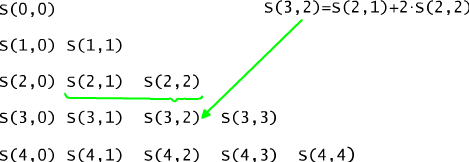
| « previous section | « next section |
Now we are going to deal with a problem of the counting number of
equivalence relations i.e. binary, reflexive, symmetric as well as
transitive relations. Notice that every equivalence relation over
an arbitrary set X determines its partition into disjoint
non-empty
blocks that cover all of X, and vice versa, every set's partition
determines the equivalence relation (see lecture 4).
Observation. To count the number of equivalence relations over some set
X
one may count the number of different set's partitions.
We restrict our considerations to finite sets only. Let be given an n-element set X and its partition into k blocks X1, X2, ..., Xk. As we know from the subsection 4.4, there exists a mutually unambiguous correspondence between k-parts partitions and equivalence relations over the set X which have k different abstraction classes.
Definition 12.3.1
A number of partitions of an n-element set into k blocks (parts, subsets) is called Stirling's number of the second kind and we denote it with the symbol S(n,k).
According to this definition, we can conclude that
S(n,k) = 0, when k>n, S(n,n) =1, S(n,1) = 1, S(n,0) = 0 for n>0.
Before we do more precise research into Stirling's numbers S(n,k) we
want to analyse a few examples.
Example 12.3.1
{{1}, {2,3}}, {{2}, {1,3}},{{3}, {1,2}}.
This set has only one division into 3 blocks, i.e. {{1}, {2}, {3}}. Stirling's numbers of the second kind adequate to these partitions are: S(3,2) = 3, S(3, 3) = 1.
{{a,b},{c,d}}, {{a,c},{b,d}},{{a,d}, {b,c}},
{{a,b,c}, {d}},{{a,b,d}, {c}}, {{a,c,d}, {b}},{{c,b,d}, {a}}.
Thus, S(4,2) = 7.
Let's assume that the considered n-element set is built with natural numbers from 1 to n. All set's partitions into k blocks may be divided on into two types:
(a) partitions which include a 1-element block {n},
(b) partitions in which n occurs in more-than-one-element blocks.
If we want to divide an n-element set into k blocks with an assumption that one of these parts is {n}, then the remaining elements must be split into k-1 blocks. Therefore, a number of such partitions is S(n-1, k-1).
Now, if we consider case (b) then it is enough to take all k-element
partitions of the (n-1)-element set into k blocks (we omit
the number n) and after that add n to one of blocks in each
partition. Of course, the number n may be added in k different ways to
each
partition. As the number of partitions of the (n-1)-element set
into k blocks is equal to S(n-1, k), summing up all, we obtain k*
S(n-1, k) partitions of the type (b).
It implies the following recursive equation
S(n,k) = S(n-1, k-1) + k* S(n-1, k). (*)
Using it a few times we may easily derive
that S(7,3) = 301. Indeed:
S(7,3) = S(6,2) + 3*S(6,3) = [S(5,1) + 2*S(5,2)] + 3*[S(5,2) + 3*S(5,3)] = S(5,1) + 5*S(5,2) + 32 * [S(4,2) + 3 * S(4,3)] = ... = S(5,1) + 5*S(4,1) + 19*S(3,1) + 65*S(2,1) +130*S(2,2) + 81*S(3,3) = 301.
Let's go back to the equivalence relations problem. It is obvious that an equivalence relation over an n-element set has or one or two or ..., n abstraction classes. Hence, according to the observation above, the following theorem holds:
Theorem 12.3.1
There are Σ k=1,...,n S(n,k) different equivalence relations over an n-element set.
The sum in the above mentioned theorem is known as the Bell number B(n). It seems that counting S(n,k) values for arbitrary n and k is not a very complicated task, especially when we use a computer. Equation (*) implies an easy recursive algorithm. Unfortunately, as it is in the Pascal's triangle case, we cannot use the recursive method here (why?). To go around this problem, we should use an auxiliary triangular matrix to memorise values computed in advance. We order S(n,k) values in the manner called Stirling's triangle, see Figure 12.3.1.

Fig. 12.3.1 Stirling's triangle.
In order to fill up the S(n,k) position in the n-th row and k-th column we add value S(n-1,k-1) (previous row and previous column) multiplied by k to S(n-1,k) (previous row, the same column). Therefore, to fill up a row of the matrix we need knowledge about values in the previous row. An algorithm which does this task (fills a Stirling's triangle up to the k-th column) may be implemented as follows:
procedure Stirling( n,k)
{ for i :=1 to n do S(i,0) := 0; S(i,1):=1; od;
for i := 0 to n do S(i,i) := 1 od;
for i := 3 to n do
for j := 2 to k do
S(i,j) :=
S(i-1,j-1) + j* S(i-1,j)
od
od
}
This algorithm is easy but also very impractical. That is because Stirling's numbers grow extremely fast.
Question 12.3.1 Find a formula for the number of ways to
distribute r distinct persons into n different initially empty rooms,
so that exactly
m rooms were non-empty, m< n.
| « previous section | « next section |